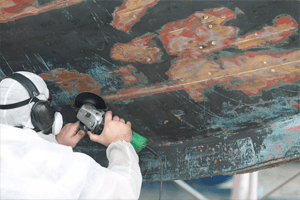Series on Safety: Lead Paint Poisoning

What: Paint containing lead poisons all systems of the human body. After ingestion or consumption, lead pollutes the blood and results in damage to the brain and central nervous system. High exposure can produce convulsions and eventually lead to a coma or death. Low exposure still affects brain development, especially in young children. Lead paint poisoning has been shown to reduce IQ and attention span, increase antisocial behavior, and decrease academic achievement. Affected adults may see increased risk of kidney failure and raised blood pressure.
Where: Lead paint can be found on the outside or inside of older homes as well as on antique furniture and toys, and candy from Mexico. Costume jewelry and other toys passed down through generations within a family might be posing a lead paint poisoning danger.
When: As the lead paint on various surfaces begins to peel and decay, it often crumbles into a dust-like substance carried through the air and able to be ingested. In addition, studies claim that children under the age of 6 are at an increased risk of consuming lead by touching items with deteriorating paint and then putting their hands in their mouths.
Symptoms: While there are no obvious symptoms, an affected individual may demonstrate tiredness, hyperactivity, irritability, poor appetite, weight loss, trouble sleeping, or stomach aches. Because these symptoms may go unnoticed or attributed to other things, lead paint poisoning often goes unchecked. If you suspect someone you know is being poisoned by lead paint, encourage them to get a blood test.
Action: Once lead paint has been ingested or consumed and takes its toll on the body, there is no known countermeasure to undo the damage. Therefore, it’s imperative to take preventative measures.
Prevention: Lead paint poisoning can be prevented (especially in children) in several ways.
- Check the date of the buildings and houses your where you and your children spend the most time. If any were built prior to 1978, consult a local health official and take measures to reduce prolonged exposure until you know if the lead paint has been removed.
- Keep pregnant women and children away from renovations, especially renovations for structures older than 1978.
- Wash children’s hands and toys regularly.
- Keep children from playing in bare soil. Use a sandbox instead.
- Create barriers between your family and any items known to contain lead paint. Fence your house off from the older house next door or keep antique furniture in a room young children don’t enter.
- Keep your house free of dust by cleaning consistently.
- Get an inspection!
Lead paint poisoning is a serious health concern facing many countries. Even though the United States has banned the use of lead-based paint, old houses and antique or imported items may still pose a considerable threat.
Take preventative steps to protect your family from lead paint poisoning. Seek blood tests if you suspect exposure. And consider the inspection services from Inspect-It 1st to see if the painted surfaces or dust in your home are contaminated.
